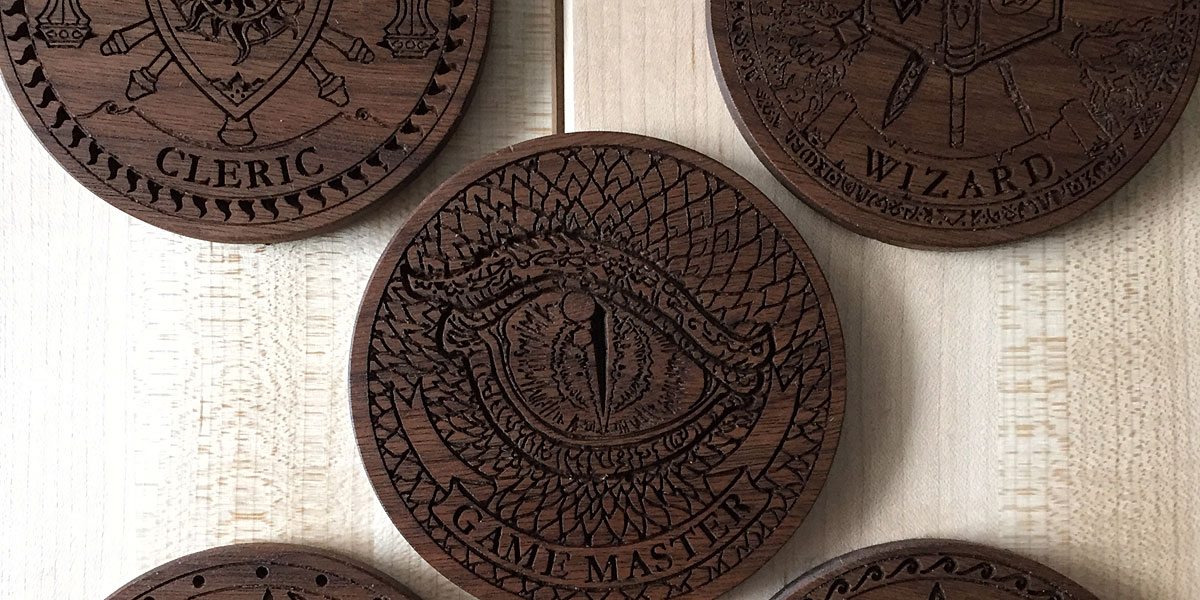Giant leviathans called cresters soar through the sky of the gaseous planet of Celus. Brave captains sail their flying ships through the windy skies to hunt these great beasts and harvest them for gas as well as notoriety. These captains are not above attacking each other to take the spoils of another’s hunt. Do you have what it takes to succeed in this harsh, unforgiving environment?
What Is Windward?
Windward is a game for 1-5 players, ages 14 and up, and takes about 30-90 minutes to play. It sells for around $49 and is currently available directly from PlayMonster as well as from Barnes and Noble. Windward was designed by Hayden Lapiska, Daniel Aronson, and Nick Tompkins and published by PlayMonster with illustrations by Justin Spice.
Windward Components
The game includes the following:
- 6 Board tiles
- 1 Trading Post with flag
- 5 Ship status boards
- 1 Trading post board
- 5 Ship pieces
- 10 Longboat pieces
- 10 Mate pieces
- 10 achievement tokens
- 15 Status trackers
- 8 Gray cresters
- 8 Red cresters
- 1 White crester
- 8 Gray crester teeth
- 8 Red crester teeth
- 1 Blue wind die
- 8 Black battle dice
- 74 Supply cards
- 15 crew tiles
- 100 Gas/Cannon tokens
- 16 “+2” tokens
- 5 Coffee tokens
- 6 Naturalist tags
- 11 Life tokens
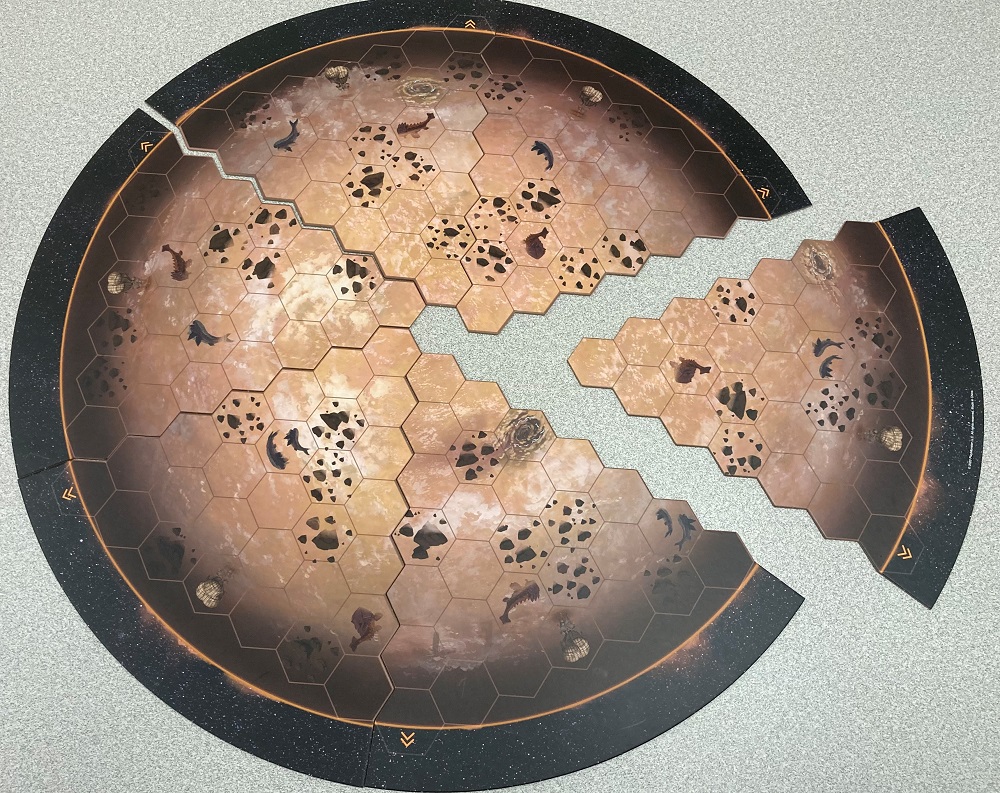
The six board tiles can be shuffled and then arranged to form a circular board representing the planet Celus. On the flip side of the tiles is a smaller-sized map used for 2-player games or for a greater challenge.
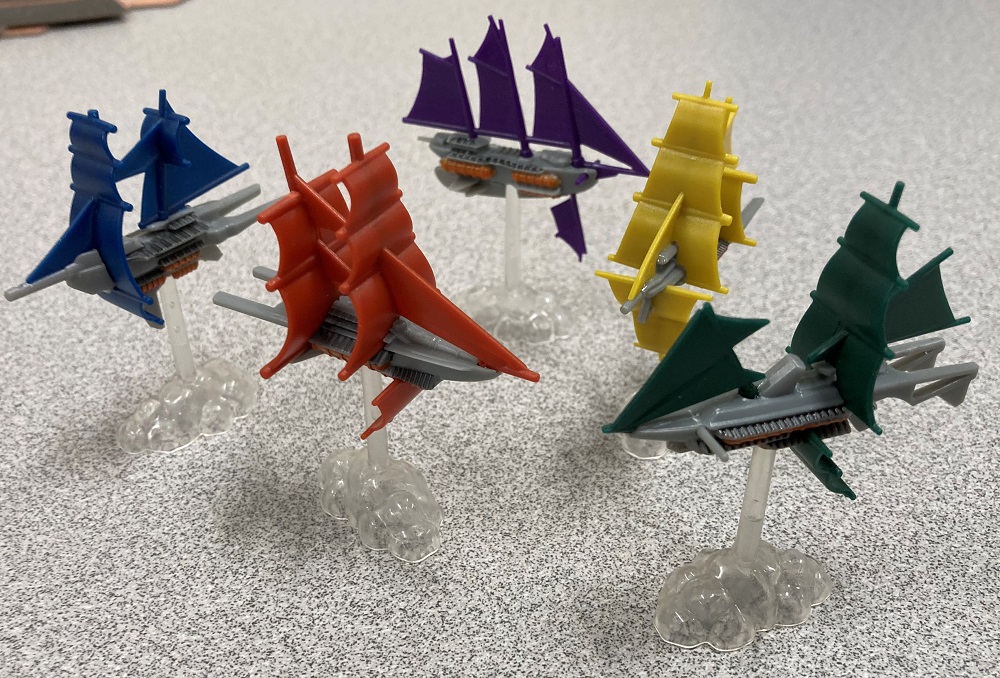
Each player takes control of one of these pre-painted ships useful for sailing through the atmosphere of Celus.
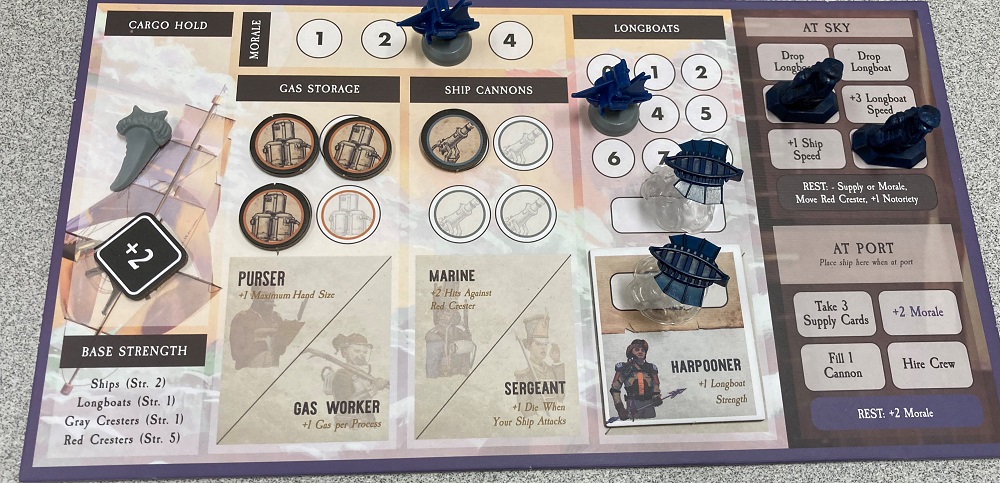
Ship status boards are used by each player to keep track of the items the ship is carrying, any crew, the status of longboats, and orders performed by your mates. Each board has one order or ability that is different from the other ship boards. For example, the blue ship adds 2 morale rather than only one when ending a turn at the port or when assigning a mate to increase morale.
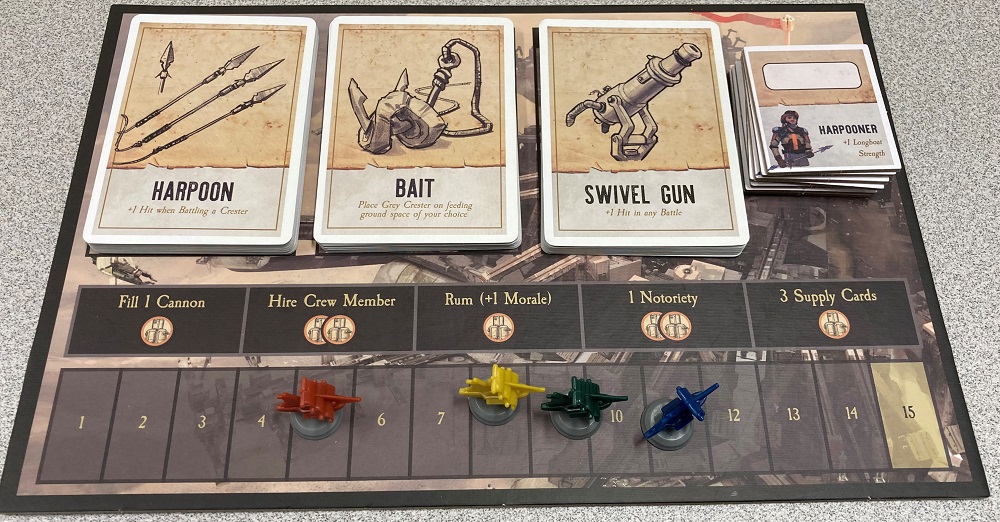
The trading post board not only keeps track of each player’s notoriety but also offers supply cards and crew for purchase. It can be accessed by players when their ship is at the trading post.
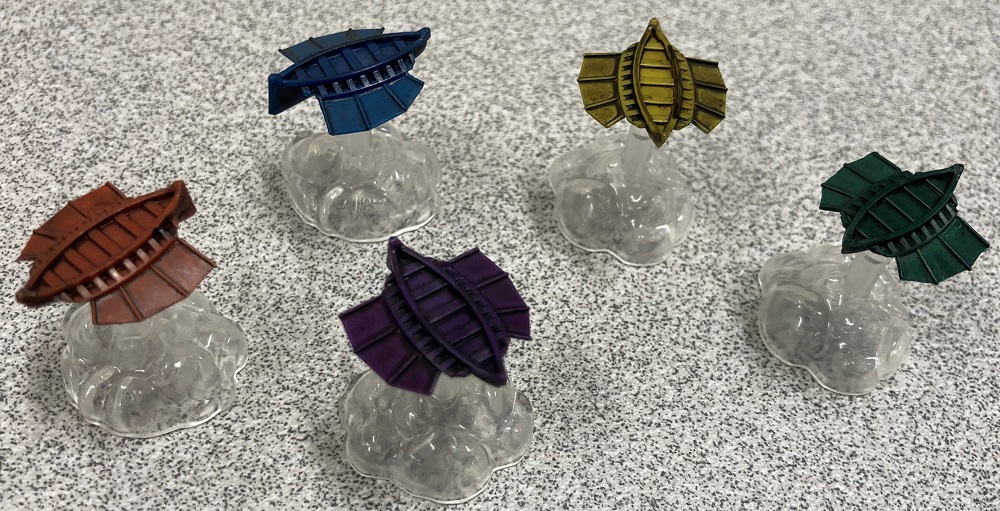
Longboats are carried by ships and can be dropped into the lower atmosphere to hunt the gray cresters. Players can deploy one longboat at the start and then deploy a second longboat by hiring certain crew members.
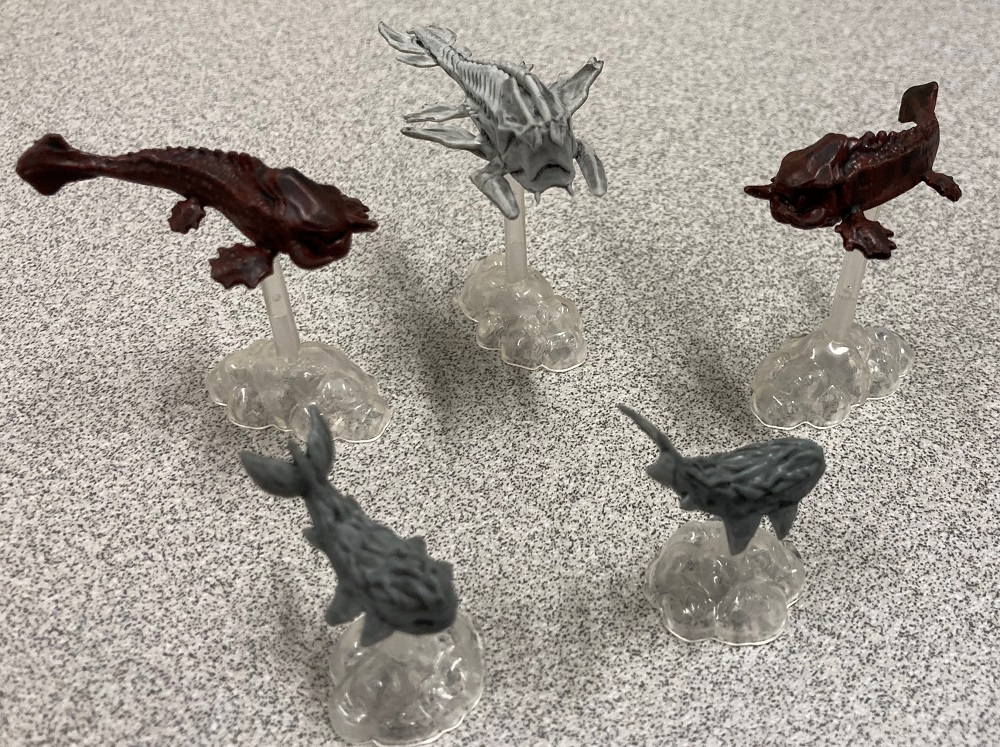
In order to gain the most notoriety, players must hunt for the gray and red cresters. There are always six red cresters on the map while the number of gray cresters varies according to the number of players. The gray cresters are considered at low altitude while red cresters are at high altitude. The white crester is used for an advanced variant.
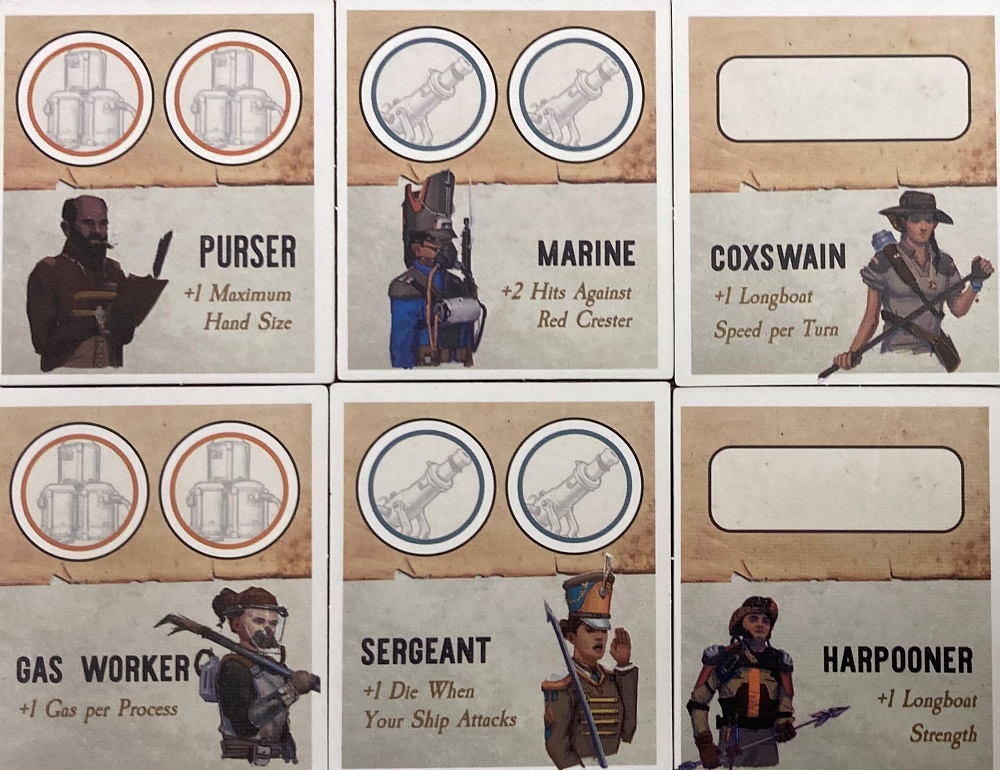
Hiring a crew provides some great bonuses for your ship. You can only hire three during a game, so choose those that benefit your style of play.
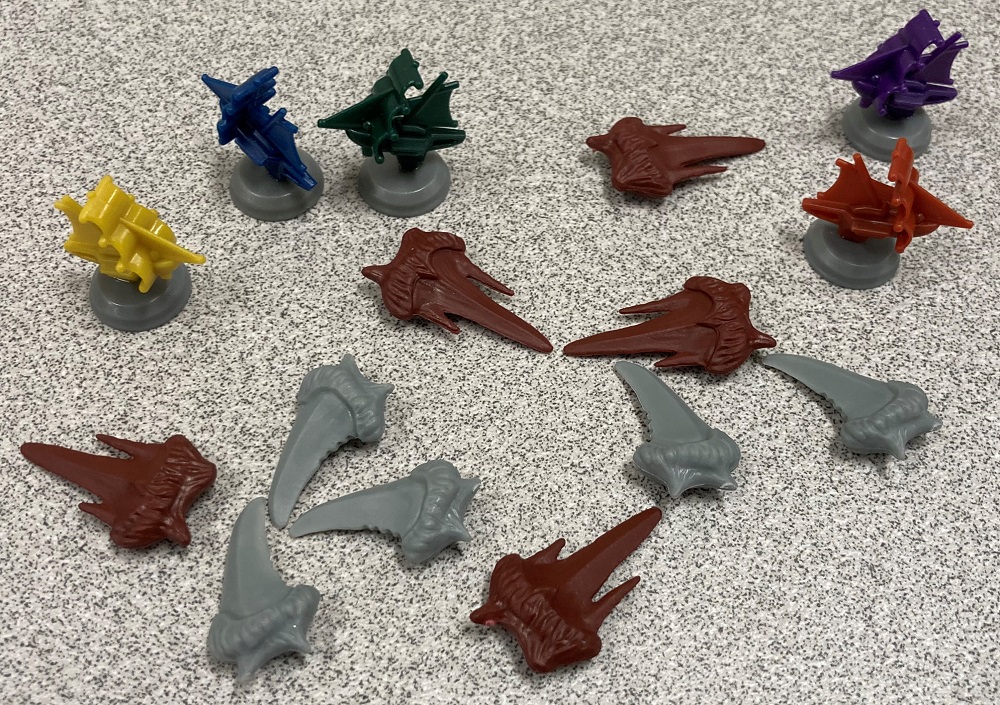
Small ship miniatures are used by players to keep track of their ship’s morale, their longboat speed, as well as their notoriety. Each player has three of these status trackers. Once a crester has been caught and processed, you receive a tooth of that crester type which you can take back to port and cash in for notoriety.

The main tokens used in the game are the gas and cannon tokens. They are double-sided with gas on one side and cannons on the other. The “+2” tokens are rewarded as a consolation when you lose a battle and provide 2 additional hits when spent on a future fight. Other types of tokens are used for game variants.
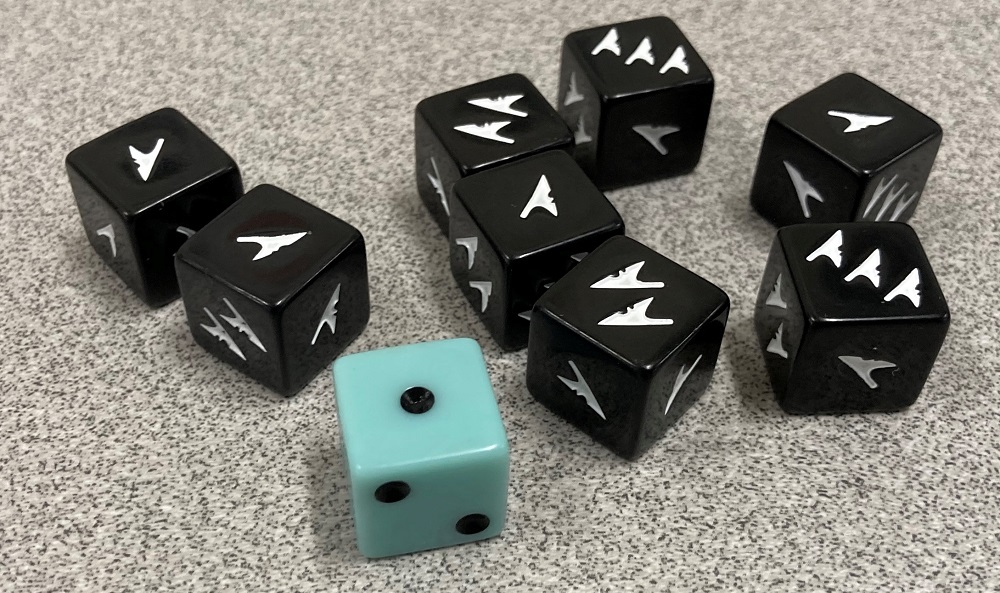
The blue wind die is used to determine the direction the wind blows, which changes each turn. Battle dice are used to determine hits during a battle.
How to Play Windward
You can download a copy of the rulebook here.
The Goal
The goal of the game is to have the most notoriety points at the end of the game. Notoriety is earned by returning crester teeth to the trading post, remaining in the sky at the end of your turn, earning achievements, and trading gas for these points.
Setup
Start off by shuffling all the board tiles and placing them into a circular layout to create the planet Celus. Place the trading post in the opening at the center of the board tiles and position the flag on top of the trading post. Each player then takes a ship status board and collects all of the pieces of the corresponding color including a ship, 2 longboats, 2 mates, 3 status trackers, and 2 achievement tokens. Place a status tracker on the “1” for morale and “0” for longboat speed. The third status tracker is placed to the side of the trading post board.

Roll the blue wind die to determine who will be the first player. That player remains the first player throughout the game. Play will move around the table in a clockwise direction. Shuffle the supply card deck and deal out 2 supply cards to the first player, 3 cards to the second player, 4 cards to the third player, and 5 cards to any remaining players. Divide the remaining supply cards into three semi-equal stacks and place them face-up on the trading post board.
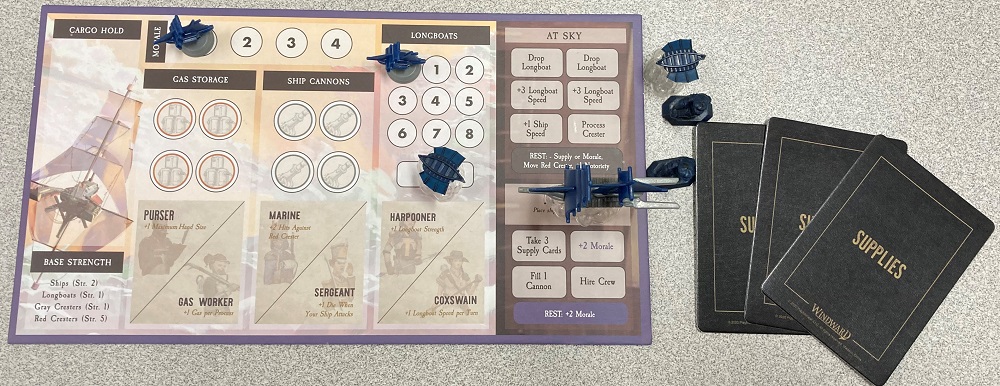
Roll the wind die again and place a gray crester on the feeding grounds space on the board tile touching that number on the base of the trading post. Repeat the process until you have placed a number of gray cresters equal to one less than the number of players. So you would place 3 cresters for a 4-player game. Then place a red crester on each red crester starting spaces on the board. Next place two gas tokens on each of the gas pocket spaces. Finally if playing with achievements, place two achievement cards face up by the trading post board.
Gameplay
Windward is played in rounds with each player taking a turn. At the start of a round, the first player rolls the wind die and then moves the flag on the trading post so it is pointed in the corresponding direction.
Taking a Turn
During a turn, players can do any or all of the following actions: move their ship, move longboats, give orders, spend gas, use a supply card, or initiate a battle. When a player finishes their turn, they then complete the turn end steps.
Each player receives four movement points for their ship at the start of the turn. They do not have to be all used at one time but can be divided up over the turn. Wind plays a major role in ship movement. You cannot move in the direction opposite the wind. Moving in the same direction as the wind costs no movement points. Moving at any other angle to the wind costs 1 movement point per space. In addition, leaving the trading post or docking at the trading post also costs one movement point. Therefore, a lot of what you can do on a turn really depends on the wind. Longboats are not affected by the wind. They move using longboat speed points at a cost of one point per space they move.

Once you have collected gas tokens, you can spend them while your ship is docked at the trading post. You can use them to hire crew, gain cannon tokens, purchase supply cards, increase morale, or trade for notoriety. Supply cards can be used at any time as long as they are applicable and you can use as many as you want. You can only have five cards in your hand at a time, though one crew member can increase your hand size to six.
The orders you can give depends on whether your ship is docked at the trading post or out in the sky. These orders are found on the ship status boards. Each player can give two orders per turn using their mate figures. Playing a Coffee supply card can give you an extra order for the turn. While at the port, you can spend an order to take 3 supply cards, increase your morale, add a cannon token to your ship, or hire a crew. Each ship can hold three crew members, each of a different type. Some can increase your gas storage, others your maximum amount of cannon tokens you can carry, and the last type lets you use two longboats instead of only one. Each crew also provides an added bonus as well. There are different orders available while your ship is out in the sky. Dropping a longboat from your ship costs an order. You can also spend orders to increase your longboat speed tracker, gain an extra movement point for the turn, or process a captured crester into gas and a tooth. You get one tooth per crester and a number of gas tokens equal to your current morale. Most orders can only be done once per turn while a few can be done twice.
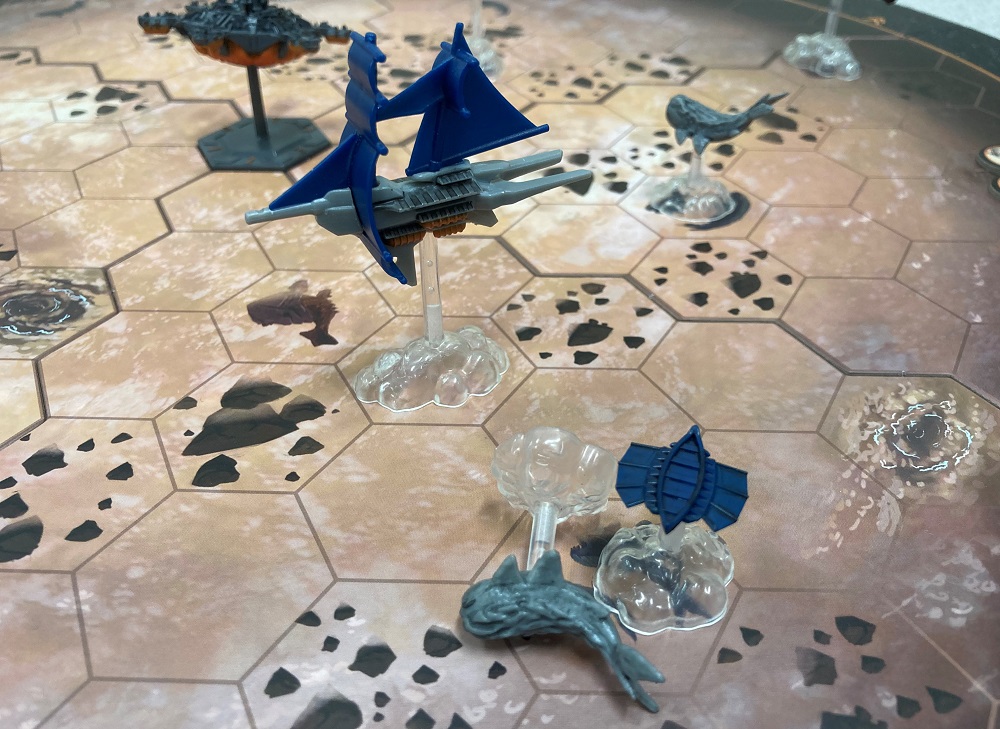
When a player has completed all of their movement and as many orders as they wish to use, they then complete the steps for the end of the turn. If they end their turn in port at the trading post, they move their mates to the rest spots and then increase their morale by one. If instead, they remain out in the sky, they first move the mates to their rest spot and then must either decrease their morale by one or discard a supply card. Next, they move the red crester on the same board tile as their ship 3 spaces towards their ship. If it reaches their ship, a battle begins. If the ship is still out in the sky after this, then the players receive 1 notoriety point.
Battles
If a ship, longboat, or red crester moves into a space with an opposing ship, longboat, red crester, or gray crester, and the pieces are at the same altitude, a battle begins. When a player is in battle against a crester, the player to the left rolls for the crester. At the start of a battle, players calculate their total strength. Ships have a strength of 2, longboats have a strength of 1, gray cresters have a strength of 1, and red cresters have a strength of 5. Ships can spend cannon tokens to increase their strength by one per token. The attacker rolls a number of battle dice equal to their strength and counts the number of harpoons shown. The defender then rolls battle dice equal to their strength and adds up the harpoons. The attacker may now play supply cards or “+2” tokens to increase their number of hits followed by the defender doing the same. Cresters cannot play supply cards or tokens. Whoever has the highest number of hits is the winner. If it is a tie, the attacker moves back to the previous space they were and both sides gain a “+2” token. The attacker can continue their turn, but may not initiate another battle against the same target this turn.
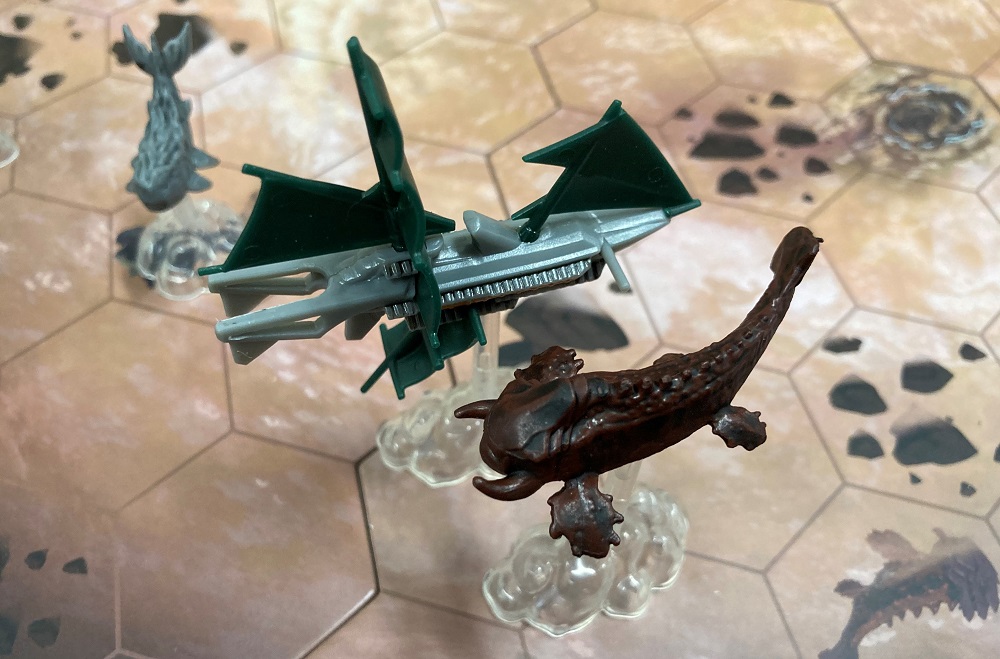
If a ship loses a battle, lower the ship’s morale by the difference between the number of hits. For example, if one ship had 10 hits, and the other 8 hits, the losing ship would decrease their morale by 2. If a red crester loses a battle, place the red crester piece in the winning ship’s cargo hold. The winning player then places another red crester anywhere they want in that same board piece. When a gray crester is defeated, remove the base and place the piece in the space with the longboat that defeated it. The longboat is towing it. Roll the wind die and place a new gray crester on the matching feeding ground. Roll again if that space is already occupied. Finally, if a longboat loses a battle, it is returned to its ship. Whenever a ship or longboat loses a battle, that player gains a “+2” token.
A ship whose morale drops to zero is considered defeated. If defeated by a red crester, drop all items in the cargo hold into the space. If defeated by another ship, any crester in the ship’s hold is transferred to the winner. The winner then selects half of the remaining items, rounded up, to take from the defeated. They do not take gas or cannon tokens or supply cards. Now the defeated ship sets its morale to 1, places the ship in port, and puts a “+2” token into its cargo hold.
Game End
When a player reaches 15 or more in notoriety, they finish their turn. Then each other player completes one more turn. At the end, whichever player has the most notoriety is the winner. If there is a tie, then play another round until there is a winner.
Why You Should Play Windward
Windward is a very enjoyable game with a lot of strategy and tactics built right into it. The mates and orders provide a worker placement mechanic. Instead of competing for worker slots with other players, the orders are all individually on each ship. Having only two mates limits the number of orders you can give during a turn, so you have to think a few turns ahead, and picking up Coffee supply cards that provide an extra order can really make a difference. The ever-changing wind direction is another feature I really enjoyed. Since it changes each turn, players have to stay flexible. By sailing in the same direction as the wind, you can go far. However, you have to avoid spaces that are impassible and break up the map. If the wind is really not to your liking, you can always play a supply card that lets you roll again to change the wind. In addition, since movement can be broken up, players have a lot of flexibility. By using the wind, you could sail into port, do all the in-port actions, then leave and continue on to go after a crester.
Hunting cresters is dangerous business, especially early in the game before you get cannon tokens or hire a crew. However, defeating cresters is how you win the game. Having several supply cards that provide additional hits during a battle can help early on. I like how players can roll their battle dice first and see the results before they have to play supply cards to increase the number of hits. Another aspect that keeps players on their toes is the way the red cresters move towards ships that end their turn away from port. Therefore, if you are not wanting a fight, you need to ensure that your ship is out of reach of these dangerous creatures.
While the main “free-for-all” game is for 2-4 players, there are several variants. The solo adventure requires a player to defeat all the red cresters as well as the white crester while not being able to end their turn in port. A five-player game has the fifth player take on the role of a naturalist who earns notoriety by tagging rather than processing cresters while also trying to protect the cresters from the other players. A cooperative adventure has all players working together to defeat the white crester. These variants add a lot of replayability to the game.
I have had a lot of fun playing Windward. The sci-fi nautical theme has a sail-punk (wind, not steam) feel, which really adds to the game. The challenge in Windward is to plan your turn so you can accomplish as much as possible. In fact, the players who can maximize their actions each turn are usually the ones who will win the game. If you are someone who enjoys a thinking game where you have to carefully plan your orders and plot your movement to outmaneuver your opponents, then I highly recommend Windward as a great game to add to your collection. It is easy to learn but will take some time to master.
Click here to see all our tabletop game reviews.
![]() To subscribe to GeekDad’s tabletop gaming coverage, please copy this link and add it to your RSS reader.
To subscribe to GeekDad’s tabletop gaming coverage, please copy this link and add it to your RSS reader.
Disclosure: GeekDad received a copy of this game for review purposes.





